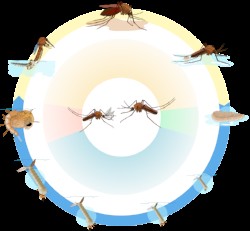Mosquitoes, belonging to the Order Diptera and Family Culicidae, are incredibly adaptable insects thriving across diverse environments worldwide. From subterranean mines to towering mountain peaks, and even in your backyard, these insects are masters of survival and reproduction. While not all mosquito species pose a direct threat to humans, many significantly impact our quality of life and act as vectors for diseases. Easily distinguished from other flies by their piercing proboscis and scaled wing veins, there are around 176 species in the United States and over 3,000 globally. Understanding these ubiquitous pests, particularly how long mosquitoes live, is crucial for effective prevention and control.
Delving into the Mosquito Life Cycle
The mosquito life cycle is a fascinating transformation that occurs in four distinct stages: egg, larva, pupa, and adult. All mosquitoes rely on standing water to breed, but their habitat preferences vary. Some species, known as “floodwater” mosquitoes, favor temporary water bodies, while “permanent water” mosquitoes breed in more sustained water sources. Others are highly specialized, depositing eggs only in specific containers, both natural and artificial. Regardless of species or habitat, every mosquito progresses through these four stages, with the larval and pupal phases being exclusively aquatic.
The Egg Stage: Beginning Life in Still Water
The mosquito life cycle commences with the egg stage. Female mosquitoes lay their eggs in various ways depending on the species. Eggs can be laid individually or in clusters known as rafts, directly on the water surface, along water edges, in tree holes, or in areas susceptible to flooding. Hatching time is temperature-dependent, often occurring within days. Remarkably, some mosquito eggs laid in dry locations can remain dormant for extended periods, even years, awaiting ideal conditions like rainfall or flooding to trigger hatching. Mosquitoes frequently overwinter as eggs, ensuring species survival through colder months, though some species may also overwinter as larvae or adults.
The Larval Stage: Aquatic Feeding and Growth
Upon hatching, the larval stage begins. Mosquito larvae, often called “wigglers” or “wrigglers” due to their movement, typically hang from the water surface to breathe. They possess a siphon, an air tube extending from their posterior, acting like a snorkel. Larvae are filter feeders, consuming microorganisms near the water’s surface. When disturbed, they exhibit a characteristic “S” shaped swimming motion to dive deeper as a defense mechanism. Growth during the larval stage involves molting, where larvae shed their exoskeletons to accommodate their increasing size. These stages between molts are termed instars, and the larval stage consists of four instars in total. The duration of the larval stage is influenced by species, water temperature, and food availability, generally ranging from 4 to 14 days.
The Pupal Stage: Transformation in Tumbling Form
The pupal stage marks a period of transformation. Mosquito pupae, also known as “tumblers” due to their tumbling motion when disturbed, cease feeding. Despite not eating, pupae remain active and responsive to their environment, sensitive to light and shadows, and requiring air from the water surface to breathe. They use a tumbling or rolling motion to escape threats by diving into deeper water. The pupal stage is relatively short, lasting approximately 1.5 to 4 days. This stage culminates when the pupal skin splits along the back, and a fully formed adult mosquito emerges, resting briefly on the water surface before taking flight.
The Adult Stage: Lifespan, Feeding, and Reproduction
The adult mosquito emerges from the pupal stage, with males typically appearing first and congregating near breeding sites to await females. Mating occurs rapidly after emergence due to the high mortality rate of adult mosquitoes; populations can decline by as much as 30% daily. To counteract this, females lay numerous eggs, ensuring species survival. Male mosquitoes generally live for only 6 to 7 days. Their diet consists mainly of plant nectar, and they do not feed on blood. Female mosquitoes, however, can live significantly longer, up to 5 months or more under ideal conditions, with an average lifespan of about 6 weeks. To develop eggs, female mosquitoes require a blood meal, in addition to nectar for energy. They locate hosts by sensing carbon dioxide, trace chemicals in breath, and body heat. Mosquitoes are highly sensitive to compounds like carbon dioxide, amino acids, and octenol, aiding in host detection. While the average flight range for a female mosquito is 1 to 10 miles, some species can travel up to 40 miles in search of a blood meal. After each blood meal, the female lays eggs (oviposition), completing the life cycle. Some species lay eggs only once, while others oviposit multiple times throughout their lifespan.
Understanding the lifespan of mosquitoes, particularly the longer-lived females, is crucial for implementing effective mosquito control strategies and reducing the risk of mosquito-borne diseases. By targeting breeding sites and adult mosquitoes, we can disrupt their life cycle and minimize their impact on human health and well-being.

